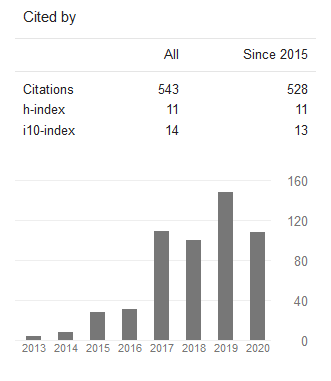Penentuan Jenis Tanaman Berdasarkan Kemiringan Lahan Pertanian Menggunakan Adopsi Linier Programming Berbasis Pengolahan Citra
DOI:
https://doi.org/10.24002/jbi.v10i2.2253Abstract
Abstract.
The slope is a measure of the slope of the land relative to the flat plane which is generally expressed in percent or degree. Agricultural land that has a slope of more than 15 ° can be more easily damaged. In this study, a value of 2.5 ° was used in determining the normal slope. The process of implementing a decision support system used linear programming adoption in determining the slope and rotation of the slope of the land and determining whether the normalization of the image input was necessary or not. The purpose of this research is to determine the time needed to determine the plant types based on angle rotation setting determined by the user. The results of the study shows that the greater height and width of an object, the longer time needed to determine the plant types, land price and the land slope. The results of the study were obtained in conducting five tests. Tests 1 and 2 images with height and image width ranged from 150-480 obtained time for normalization of 15-30, testing 3.4.5 images with height and image widths ranging from 322 and 788 requiring 54- 108.
Keywords: Slope, Adopting Linear Programming, Decision Support Systems
Abstrak.
Kemiringan lereng merupakan ukuran kemiringan lahan relatif terhadap bidang datar yang secara umum dinyatakan dalam persen atau derajat. Lahan pertanian yang mempunyai kemiringan lebih dari 15° dapat lebih mudah rusak. Pada penelitian ini digunakan nilai 2,5 ° pada penentuan kemiringan normalisasi.Proses implementasi system pendukung keputusan menggunakan adopsi linier programing dalam menentukan sudut kemiringan lahan, rotasi kemiringan lahan dan menentukan perlu atau tidaknya normalisasi pada input citra tersebut. Tujuan dari penelitian ini menentukan waktu yang dibutuhkan dalam menentukan jenis tanaman berdasarkan rotasi atau sudut pengedukan yang ditentukan oleh user. Hasil penelitian menunjukkan semakin besar tinggi dan lebar suatu objek semakin lama waktu yang dibutuhkan untuk menentukan jenis tanaman, harga lahan atau kemiringan lahan. Lima pengujian dilakukan dalam penelitian ini. Pada pengujian 1 dan 2, citra dengan tinggi dan lebar berkisar 150-480 didapatkan waktu untuk normalisasi 15-30. Pada pengujian 3,4,5 citra dengan tinggi dan lebar citra berkisar 322 dan 788 dibutuhkan waktu 54-108.
Kata Kunci: Kemiringan lereng, Adopsi Linear Programming, Sistem Pendukung Keputusan
References
V. Moniaga, “ANALISIS DAYA DUKUNG LAHAN PERTANIAN Vicky R.B. Moniaga,” Jurnal Agri-Sosio Ekonomi.,vol. 7, pp. 61–68, 2011.
R. Wirosoedarmo, A. T. Sutanhaji, and E. Kurniati, “Evaluasi Kesesuaian Lahan untuk Tanaman Jagung Menggunakan Metode Analisis Spasial, ” Land Suitability Assessment Of Corn ( Zea mays L .) Using Spasial Analysis Method,” Agritech, vol. 31, no. 1, pp. 71–78, 2011.
R. . Lubis and W. Agus, Buku Pintar Kelapa Sawit. Jakarta: Agromedia Pustaka, 2012.
Adrian, Supriadi, and Purba M, “Pengaruh Ketinggian Tempat dan Kemiringan Lereng Terhadap Produksi Karet (Hevea Brasiliensis Muell.Arg) di Kebun Hapesong PTPN III Tapanuli Selatan,” J. Agroekoteknologi, vol. 2, pp. 981–989, 2014.
F. Lihawa, “Tingkat Erosi Permukaan pada Lahan Pertanian Jagung di DAS Alo-Pohu Provinsi Gorontalo,” Semin. Nas. Pus. Stud. Lingkung. Hidup Indones., 2012.
D. J. Tarigan, “Keberagaman Pertumbuhan Vegetasi Penutup Tanah Pada Kemiringan Lahan yang Berbeda di Perkebunan Kelapa Sawit,” Scientific Repository IPB., 2017.
A. Bozdağ, F. Yavuz, and A. S. Günay, “AHP and GIS based land suitability analysis for Cihanbeyli (Turkey) County,” Environ. Earth Sci., vol. 75, no. 9, 2016.
T. Y. Tan, L. Zhang, and M. Jiang, “An intelligent decision support system for skin cancer detection from dermoscopic images,” 2016 12th Int. Conf. Nat. Comput. Fuzzy Syst. Knowl. Discov. ICNC-FSKD 2016, pp. 2194–2199, 2016.
M. Rahman and N. Alpaslan, “A Decision Support System (DSS) for Breast Cancer Detection Based on Invariant Feature Extraction, Classification, and Retrieval of Masses of Mammographic Images,” Licens. IntechOpen, 2018.
H. Park, S. Seo, and B. Song, “Clinical Decision Support System for Patients with Cardiopulmonary Function Using Image Processing,” Indian Journal of Science and Technology, vol. 8, no. April, pp. 83–88, 2015.
Downloads
Published
Issue
Section
License
Copyright of this journal is assigned to Jurnal Buana Informatika as the journal publisher by the knowledge of author, whilst the moral right of the publication belongs to author. Every printed and electronic publications are open access for educational purposes, research, and library. The editorial board is not responsible for copyright violation to the other than them aims mentioned before. The reproduction of any part of this journal (printed or online) will be allowed only with a written permission from Jurnal Buana Informatika.
This work is licensed under a Creative Commons Attribution-ShareAlike 4.0 International License.










